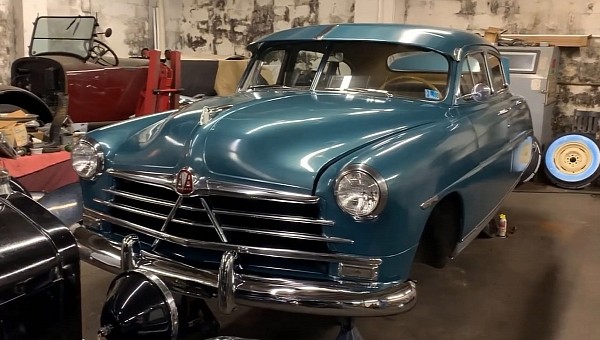When it comes to 1950s cars, we usually think about iconic nameplates like the Chevrolet Bel Air, Chrysler 300 "letter series," or the Cadillac Eldorado. But some lesser-known automobiles are just as cool design-wise and perhaps even more important when it comes to their contributions to the automotive industry.
The Hudson Hornet is one of those cars. Introduced in 1950, the Hornet dominated stock car racing from 1952 to 1954 thanks to its "step-down" design with a lower center of gravity and streamlined body. Its success also prompted Hudson to become the first automobile manufacturer to get involved in NASCAR.
The Hornet is also one of the first muscle cars, having arrived only one year after the Oldsmobile "Rocket" 88. An impressive feat given that the first-gen car relied on an inline-six mill for oomph.
Anyway, I'm not here to talk about the Hornet, a fabulous classic I already covered in a previous story. I'm here to show you a museum-grade Pacemaker that's hiding in someone's repair shop. Yes, I know, the Pacemaker is nowhere near as famous as the Hornet, but this example looks stunning and it's also a low-mileage survivor.
Documented by YouTube's "Classic Car Rescue," this Pacemaker Deluxe in metallic blue shows only 16,000 miles (25,750 km) on the odo and looks like it just left Hudson's assembly line in Detroit more than 70 years ago. The owner doesn't know if the car was repainted or not, but with no overspray on the chrome trim and the original insulation, this Pacemaker may still sport its original coating. And that's fabulous, to say the least.
But how did it survive for 72 years in such fantastic condition? Well, the owner says it spent no fewer than 40 years in a museum. On top of that, it had only two owners until it became a display piece.
The car looks just as stunning on the inside and still sports a few factory features that are incredibly rare nowadays. I'm talking about the heater and the basketweave trunk cover. And not only does it still have its numbers-matching 232-cubic-inch (3.8-liter) six-cylinder engine, but all the wiring is original as well. That's something you don't see every day.
But does it still run? Well, the Pacemaker is getting some proper maintenance as we speak, so it will become road-worthy soon. Hopefully, we will get one of those "first drive in 40 years" videos too.
If you're not familiar with the Pacemaker, the nameplate was first introduced in 1939 as a replacement for the Terraplane. Discontinued after only one year, the badge returned in late 1949 as the company's most affordable full-size car. The name was discontinued for good at the end of the 1952 model year, when it was replaced by an entry-level version of the Wasp.
Due to its limited time on the market, the Pacemaker is one of the rarest Hudson nameplates of the early 1950s. And the one you're about to see below has to be one of the finest in existence.
The Hornet is also one of the first muscle cars, having arrived only one year after the Oldsmobile "Rocket" 88. An impressive feat given that the first-gen car relied on an inline-six mill for oomph.
Anyway, I'm not here to talk about the Hornet, a fabulous classic I already covered in a previous story. I'm here to show you a museum-grade Pacemaker that's hiding in someone's repair shop. Yes, I know, the Pacemaker is nowhere near as famous as the Hornet, but this example looks stunning and it's also a low-mileage survivor.
Documented by YouTube's "Classic Car Rescue," this Pacemaker Deluxe in metallic blue shows only 16,000 miles (25,750 km) on the odo and looks like it just left Hudson's assembly line in Detroit more than 70 years ago. The owner doesn't know if the car was repainted or not, but with no overspray on the chrome trim and the original insulation, this Pacemaker may still sport its original coating. And that's fabulous, to say the least.
But how did it survive for 72 years in such fantastic condition? Well, the owner says it spent no fewer than 40 years in a museum. On top of that, it had only two owners until it became a display piece.
The car looks just as stunning on the inside and still sports a few factory features that are incredibly rare nowadays. I'm talking about the heater and the basketweave trunk cover. And not only does it still have its numbers-matching 232-cubic-inch (3.8-liter) six-cylinder engine, but all the wiring is original as well. That's something you don't see every day.
But does it still run? Well, the Pacemaker is getting some proper maintenance as we speak, so it will become road-worthy soon. Hopefully, we will get one of those "first drive in 40 years" videos too.
If you're not familiar with the Pacemaker, the nameplate was first introduced in 1939 as a replacement for the Terraplane. Discontinued after only one year, the badge returned in late 1949 as the company's most affordable full-size car. The name was discontinued for good at the end of the 1952 model year, when it was replaced by an entry-level version of the Wasp.
Due to its limited time on the market, the Pacemaker is one of the rarest Hudson nameplates of the early 1950s. And the one you're about to see below has to be one of the finest in existence.









